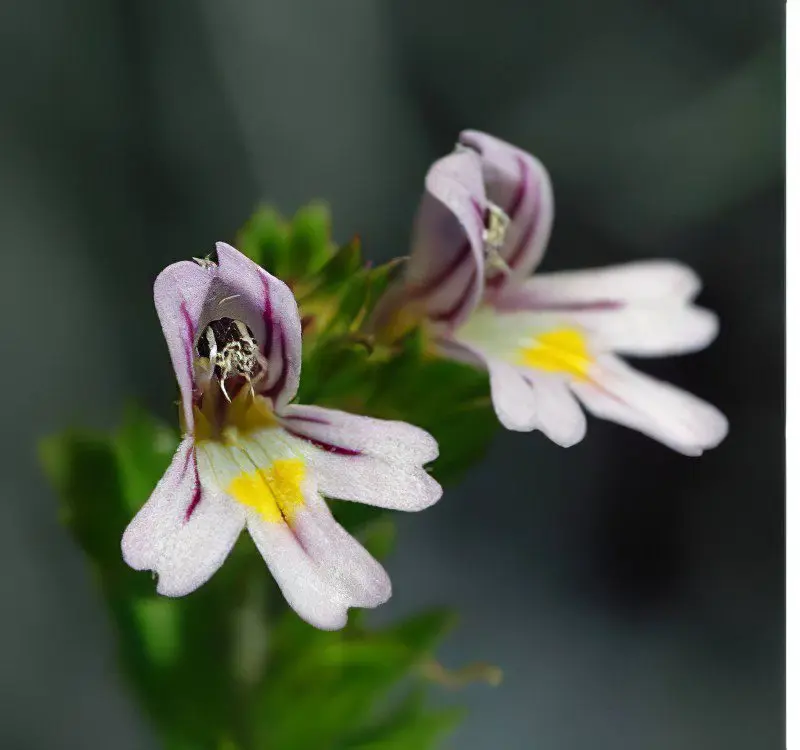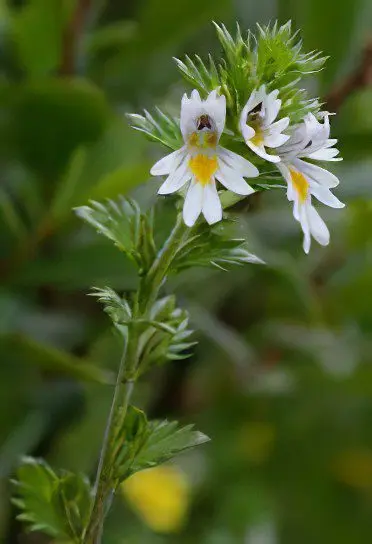Contents
Useful properties and use of eyebright
Botanical characteristics of eyebright

Ochanka – a small annual plant from the Norichnikov family with a straight, branched from the middle, soft-pubescent, reddish-brown stem from 5 to 50 cm high. The leaves of the plant are small, opposite, ovoid, with spinous teeth along the edge. Leaves fall early at the bottom of the stem. In the axils of the leaves, flower-bearing shoots develop with pale purple or white bilabiate flowers. Flowers in length do not exceed 6-10 mm, their distinguishing feature is a yellow rounded spot on the lower three-lobed lip.
Eyebright is a semi-parasitic plant that sucks out nourishing juices from cereal grasses with its roots. Its flowering period is from late summer to mid-autumn. Eyebright can be found in meadows, along roadsides, in light forests, in mountainous areas, on dry slopes, in peat bogs. It is distributed mostly in the central and southern regions of Germany, in Italy, in the Balkans, in Russia, Moldova, Ukraine and Belarus.
Useful properties of eyebright
For medicinal purposes, the aerial part of the plant is collected – flowers and leaves. They contain essential and fatty oils, flavonoids, tannins, coumarins, glycosides, anthocyanins, and vitamins. Eyebright medicinal is a real storehouse of such trace elements as silicon and magnesium, zinc and boron, iron, chromium, manganese, magnesium and others.
To preserve the healing properties of the plant, it is collected during flowering, dried under sheds in the open air or in rooms with good ventilation. For drying grass, special dryers can be used at an operating temperature of 40 ° C. After drying, the grass is crushed and stored in crates wrapped in thick paper. Ready raw materials are afraid of moisture, so they should be stored in a dry, well-ventilated place.
The use of eyebright
Eyebright has found wide application in folk medicine. It has anti-inflammatory, analgesic, enveloping, antispasmodic, hypotensive and sedative effects. In addition, eyebright preparations improve the blood supply to the brain, reduce eye pressure, increase immunity and relieve swelling.
The use of infusions and decoctions of herbs is justified for coughing, acute respiratory infections, bronchitis, tonsillitis. They help with memory disorders, problems with the gastrointestinal tract, gastric catarrh, enterocolitis, gastritis with high acidity, and allergies. Eyebright is also used for hypertension, rheumatism, and gout. The plant is included in most cardiac herbal preparations due to the presence in its composition of glycosides of the cardiac group.
The healing properties of eyebright have been proven in the treatment of eczema and diathesis. It has a positive effect on the scalp, promoting hair growth and improving their structure.
Eyebright
Eyebright preparations are used to treat various eye diseases, ranging from simple eye fatigue during prolonged work at a computer or while reading in dim light, to such serious diseases as cataracts and glaucoma.
For internal use, decoctions, infusions, tea or juice are used, for external use – various compresses, baths and lotions. With farsightedness or myopia, calendula flowers can be added to eyebright, which will enhance the effect of drugs. When treating barley, it is recommended to add chamomile. Fennel fruits will increase the antiseptic properties of eyebright.
eyebright tincture

Eyebright tincture is a good prophylactic for maintaining vision, it can also be taken by children. The tincture relieves fatigue and the feeling of “sand in the eyes”, it is effective in glaucoma and cataracts. Treatment with the drug takes place at the tissue level, this is the advantage of eyebright tincture. It is a good antiseptic and pain reliever.
Recipe 1. For 50 g of dry eyebright herb, it is necessary to use 220 ml of 70% alcohol, infuse for ten days in a glass dish in a dark room at a temperature of 20–25 ° C, shake once every two days. The maximum shelf life of the tincture is five years.
eyebright extract
Eyebright extract has medicinal properties many times greater than those of the herb itself. In laboratory studies, it became known that the plant extract has a positive effect on visual acuity, reduces inflammation, even has a therapeutic and prophylactic effect on degenerative-dystrophic processes in the shell of the eye, and also reduces swelling of the eyes and slows down age-related metabolic disorders.
Eyebright extract treats such respiratory diseases as tonsillitis, flu, asthma, bronchitis. It is used for inflammation of the gastrointestinal tract, diseases of the genitourinary system, and cardiovascular diseases. The drug can be used in the form of baths, poultices and lotions, dry extract – in the form of powder. Similarly, skin diseases are treated – dermatitis, eczema, warts. In the treatment of these diseases, the drug is used both inside and in the form of lotions, instillations, washings.
An extract is an extract from a plant that is prepared with alcohol or water; it can be purchased at homeopathic pharmacies.
Eyebright infusion
Infusion of eyebright folk medicine uses for eye diseases, indigestion or lack of appetite.
Recipe 1: 200 ml of boiling water will need 10 g of dry chopped grass. It is poured with boiling water and allowed to brew for three hours, then filtered. The infusion is taken three times a day for half a cup.
Recipe 2: in 200 ml of cold water you need to pour 2 teaspoons of chopped eyebright, bring to a boil and leave for 2-3 minutes. It is recommended to drink the remedy half a glass four times a day.
Ochanka is upright

Eyebright is a semi-parasitic plant, it has suction cups on its roots, with which it clings to the roots of other plants and thus takes water from them. The stem of the eyebright is erect, straight, sometimes branched in the lower part. Plant height – from 1 to 50 cm. It can be red or purple. The leaves along the entire length of the trunk have a different shape, from below they are wedge-shaped with notches on the sides, and the upper and middle ones are wide, very sharp. The flowers are pale purple, on short stems, bloom along the entire length of the trunk.
At the top, the flowers are collected in a bunch. The fruits are oblong oval capsules. This species blooms from June to October. It grows in Ukraine, Belarus, the Caucasus, in the European part of Russia. Eyebright can be found almost everywhere: in a meadow, in a forest and between stones, it also grows on sandy slopes.
This species is widely used in folk medicine. The whole plant is used. Infusion is recommended for gastritis, diarrhea, hemorrhoids. The decoction is used as an anti-inflammatory and expectorant. Warm decoction is used for coughs, flu, sore throat, asthma. The decoction can be used in the form of lotions for ulcers, wounds and burns. The powder is prescribed for epilepsy and suffocation. It is also used in alcoholism. But mostly eyebright is used for eye diseases.
Recipe 1: In 200 ml of boiling water, pour 1 tablespoon of chopped herbs, leave for 2 hours and then strain. Take half a glass of medicine four times a day, wash their eyelids.
Eyebright
This is a small annual plant with a straight stem, often branched. This species has many small green leaves, sharp in the middle of the stem. The flowers are white, slightly yellow inside, collected in a bunch at the top of the plant. It blooms from June to October, grows throughout the European part of Russia.
Eyebright contains such useful substances as aukubin glycoside, essential oil, disinfectant resins, tannins. Dried or powdered leaves are used in the form of lotions, rinses.
Recipe 1. Pour 1-2 teaspoons of herbs into a quarter cup of cold water, bring to a boil and let it brew for 2 minutes. When the product has cooled, it is instilled into the corners of the eyes or used as lotions for an hour and a half a day.
Recipe 2. Pour 250 teaspoons of eyebright grass into 3 g of cold water, bring to a boil and cook over low heat for 10 minutes. The composition is used for warm baths.
Contraindications to the use of eyebright
When using eyebright for medicinal purposes, you need to know that the aqueous extract of the herb constricts blood vessels and increases blood pressure. And alcohol tincture, on the contrary, lowers the pressure.
Eyebright should not be used by pregnant women and people suffering from anacid gastritis.









